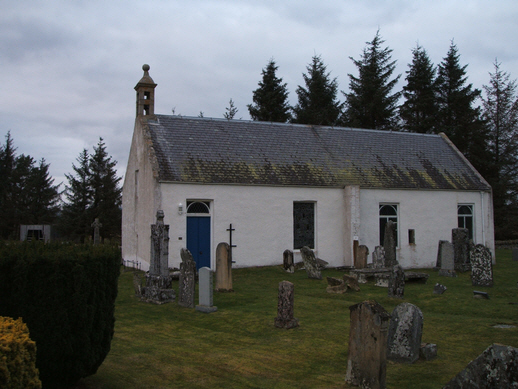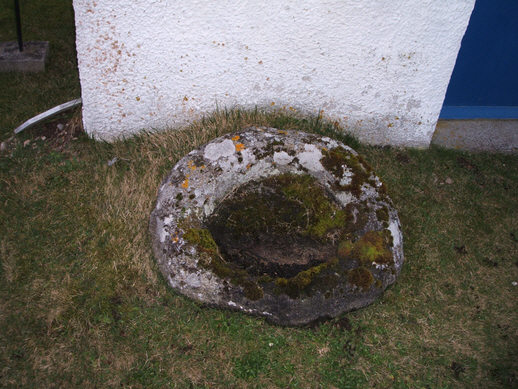 |
Kincardine. |
 |
 |
Kincardine. |
 |
Associated Chapels: Chapleton.
OS Ref: NH 938155 RCAHMS No: NH91NW 10
'Kinni-chairdin' is said to signify the 'tribe of friends'.
The church of Kincardine in very old indeed but the church at Kincardine may not be quite so ancient. Some scholars believe that the first church may, indeed, have been the one at Chapleton of Tulich although there is no doubt that the site where the present church stands is also very old. Locally, it is supposed to have been a Columban church and the foundations of the present church are said to date from the 12th century and some parts of the present fabric are certainly pre-Reformation in date. Towards the end of the 15th century the church was partly destroyed by fire (see below).
Dedicated, some say, to St Erchan, Kincardine church stands within a graveyard of almost perfect 'Celtic' shape and dimensions above the valley of the Milton Burn which flows down from the Slugan Pass. In older times the people called it 'Eaglais Thomhaldaidh'. Nothing seems to be known of St Thomhaldaidh. Some writers say the church was dedicated to St Catharine but, if true, this is probably an inheritance from the Roman times when attempts were made to replace the old Celtic names.
There were glebe lands at Deishar where once stood the school.
The church was restored in 1897
 |
|
| St Erchan's Church at Kincardine. |
 |
|
| What appears to be an ancient font lies outside the door of the church. | An old grave-safe used to thwart grave robbers. |
The church is very well cared for and is well worth a visit.
Kincardine was a barony in the later middle ages and might also have been a thanage in earlier times and was in any event regarded as distinct from Rothiemurchus and Badenoch. It seems to have included the davoch of Tulloch, and, as has been noted above, there is Chapletown near Easter Tulloch. The relationship between this chapel and the parish church is not easy to resolve. Dr Forsyth* pointed out that a ridge at Wester Tulloch, about half way between Kincardine and Chapletown, is known as Imir Thomhaldidh. He also recounts a local legend to the effect that before the church was built at Kincardine an attemp was made to found it at Wester Tulloch. Possibly the legend, preserved in a confused form, a memory that the chapel at Chapeltown was established first and dedicated to Tomhaldidh, and that the dedication was only at some later date transferred to Kincardine. In any event it appears that the davoch of Tulloch was provided with its own chapel and a fairly well-preserved site still exists at Chapelton consisting of an enclosure. The local tenant also tells of an old road which led down from Chapelton towards Kincardine. On this road, at the foot of Torr Hill, there is a place called in Gaelic "Staoir-na-Manach," the Monk's Bridge. "It is touching to picture the good Monk plodding his weary way from time to time through wood and moor, to hold service in the heights of Tulloch, and, finding the morass at the Torr almost impassable, taking pains to construct one of those rude crossing that served for bridges in those ancient days."*
Forsyth goes on to tell a typically Highland tale regarding the Lairds, of Kincardine and Tulloch. It is said that the one wanted the church built on his land, and the other was as determined that it should be erected on his. Stones were brought and laid down in Tulloch, but in some mysterious fashion they found their way before morning to Kincardine. This happened several times. At last it was accepted as a sign from heaven, and the Church was built at Kincardine!
|
|
| This lancet window shows the great thickness of the walls and is said to have been a 'leper squint'. |
Chapman, in his MS History of the Grants, tells of a terrible tragedy that was enacted in the church of Kincardine. The story is that, in the 15th century, the Laird of Grant or his son was murdered by the Cummings (Comyns) when on a visit to the Barons of Kincardine. The murderers were pursued, and took refuge in the church. The Grants, with their friends, the Stewarts, shrank away from desecrating the holy place, when one of their number solved the difficulty by shooting a burning arrow into the heather-thatched roof. The building was soon in a blaze, and all the Cummings perished save one, a man of gigantic stature, who forced his way out, but was afterwards killed by the blow of a two-handed sword, "which sword," says the chronicler, "to this day lies in the representative of Clan Cheran's house."
Further Reading.
* "In the Shaddow of Cairngorm," Forsyth. W. Inverness. Northern Counties Publishing Company. 1900. Chapter X.

e-mail: admin@cushnieent.force9.co.uk
© 2005 Cushnie Enterprises